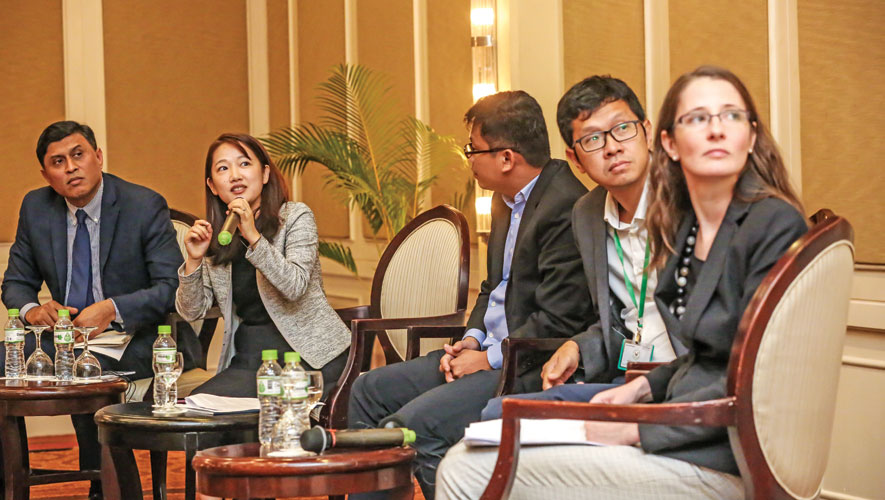There are serious concern of a shortage of liquidity across the Cambodian money and other emerging markets as policymakers and international development funds rush to ensure that lines of credit are available.
For the latest Cambodian Business news, visit Khmer Times Business
It comes as the Coronavirus pandemic has left the corporate sector scrambling for cash and causing record levels of financial outflows.
Economists have been singling out emerging economies – such as Cambodia – for extra concern during this economic crisis as developing nations are typically characterised by three aggravating economic features during a global economic shock: a large outflow of capital, an overly panicked market and a high level of leveraging against creditors that can be forced to withdraw from multiple countries en masse at the same time.
Many are now beginning to fear that a sizeable demand for US dollar liquidity will result in sharp shortages of greenbacks without strong economic measures from both central banks and intergovernmental agencies to minimise the risk of shocks evolving into an even deeper crisis and spilling over to developed countries. Record levels of FDI
The outflow of foreign direct investment (FDI) has been one of the biggest concerns for cash liquidity. Its outflow has now been recorded at its greatest levels in recent history, according to data collated by the International Monetary Fund (IMF). Record withdrawals are being attributed to the adverse effects on financial markets, consumption, investment confidence, international trade and weakened commodity prices from the impact of extreme COVID-19 health measures. It is valued to be at $100 billion globally IMF.
Data collated by the IMF has already shown that during the COVID-19 pandemic, FDI outflow from emerging markets has been almost twice as high than the now second-worst FDI withdrawal during the global financial crisis of 2007/8. It has greatly exceeded that of other economic shocks over the past 20 years such as the emerging markets sell-off in 2018, China’s currency devaluation in 2015 and the “taper tantrum” in 2013, when the US slowed printing extra money without economic support (known as quantitative easing).
FDI is defined as an investment made by a non-resident individual, company or government arm into the local economy and is considered to be a major driver for economic growth in emerging economies and provides vital cash injections to fund typically high levels of investment debt.
Cambodia attracted more than $3.588 billion of FDI during 2019, up 11.7 percent from $3.212 billion in 2018. Chinese investment accounts for 43 percent, South Korea for 11 percent, Vietnam for 7 percent, Japan and Singapore for 6 percent each and other countries 27 percent, according to the Macroeconomic and Banking Progress 2019 Report and 2020 Outlook.
The report also expected FDI to grow a further 10 percent in 2020 to $3.951 billion. However, because of the current climate, this figure is sure to be revised down.Central banks’ response.
Since the start of the pandemic, the National Bank of Cambodia (NBC – the Kingdom’s central bank) has implemented several measures to keep liquidity available such as holding off on the Capital Conservation Buffer (CCB) until next year, reducing the interest rate on the Liquidity-Providing Collateralised Operation (LPCO) up to 0.5 percent and decreasing the interest rate for the Negotiable Certificate of Deposits (NCD).
In addition to this, the NBC also reduced the interest rate of the reserve requirement to 7 percent for both local and foreign currencies for six months starting from April 2020. Before, the interest rate on the reserve requirement was 8 percent for riel and 12.5 percent for foreign currencies. It will reduce the liquidity coverage ratio (LCR) to an appropriate level if it is necessary.
Industry leader Kea Borann, Cambodia Microfinance Association’s (MFA) chairman, says MFAs have welcomed all the measures issued by the NBC and believes these measures will contribute to reducing the impact from the Covid-19 to the banking and finance sector and the economy as a whole.
“As of now, the microfinance situation remains normal with the trend of loan proposal, and outstanding deposits remaining solid, although the association, as well as its members, are monitoring closely all developments for the sector.”
However, the central bank’s measurements have been limited in their monetary effectiveness because of the Kingdom’s high level of dollarisation as outlined by previous comments made by the NBC. “While the NBC has implemented measures, its efficiency and effectiveness are limited. This is because the NBC only has access to lower interest rates effective on riels and, of course, cannot have influence over US-issued dollars,” NBC Director-General Chea Serey said.
This is why the central bank has been offering loans in riels at a low-interest rate to encourage Cambodians to take out loans in their local currency. However, even with these policies, loans in riels have decreased from 25 percent in 2016 to 10 percent this year.
“We have no control over the interest rate of US dollars. Whether the Cambodian economy is good or bad is not their [the US Federal Reserve’s] business. They take care of their people and their economy,” she added.
Alternative options for lines of credit
That said, Cambodia has been earmarked by international funds such as the World Bank and the IMF for their signature initiatives that are intended to help central banks keep vital lines of credit open throughout the crisis.
The World Bank has identified Cambodia among a group of 25 pre-emerging to emerging economies worldwide and three in the East Asia and Pacific region (Cambodia, Laos and Mongolia) that require urgent assistance to “protect their poor and vulnerable, support businesses and bolster their economic recovery”.
The IMF has also provided support through its recently released Short-term Liquidity Line (SLL) as part of its COVID-19 protection, According to the IMF, its SLL initiative has been designed as a backstop for governments and central banks who face short-term liquidity needs because of external shocks – such as the Coronavirus pandemic – that generate a balance of payment difficulties because of large outflows of FDIs from their markets and other economic factors.
The line will be available for the moderate and short-term balance of payment (BoP) needs related to capital account pressures. Arrangements will be approved for 12 months with revolving access and will have a special fee structure, which includes a non-refundable commitment cost of 8 basis points (bps) and a service charge of 21 bps.
To access the line, member nations of the IMF board will approve the extension of an “offer” and require the sole signatory of the country’s respective central bank. The IMF has predicted that the total demand for the SLL from member countries could be up to $50 billion.
Lessons of the 1997 Asian financial crisis
Economists who have reviewed the 1997 Asian financial crisis (of which Cambodia was somewhat spared because of ultra-low development) have reflected the fact the crisis was ignited by a combination of misguided financial policies with the overreaction of foreign lenders to temporary shortfalls in international liquidity rather than structural imbalances and excessive indebtedness.
As stated by the IMF, “It was [the Asian financial crisis] basically a liquidity crisis but it led to insolvencies because of misguided interventions, like crises almost everywhere else, it was preceded by a sharp increase in capital inflows, notably short-term lending by international commercial banks to both banks and firms in the region.”
While FDI outflow may have been withdrawn, on a positive note, with emerging economies typically defined as having high levels of external debt, Cambodia’s debt-carrying capacity has improved from “medium” in 2018 to “strong” in 2019, recording a relatively low external debt to gross domestic product ratio of 28.5 percent.
In summary, while Cambodia may be in a better position than other emerging economies to weather this crisis, keeping liquidity in the market will remain the biggest lesson learned to ensure local businesses remain solvent and can reopen once the pandemic is over.




